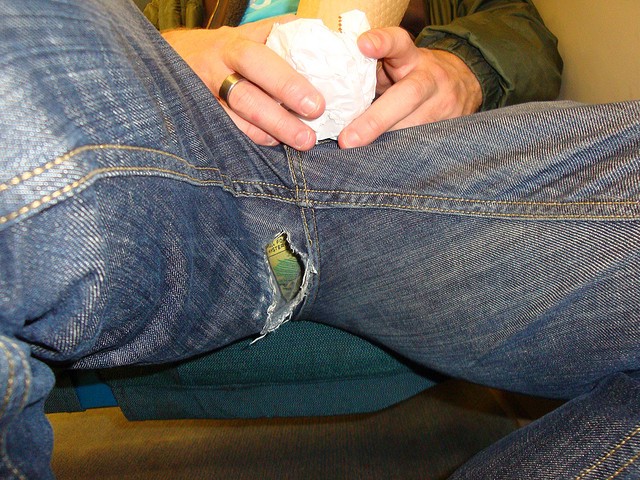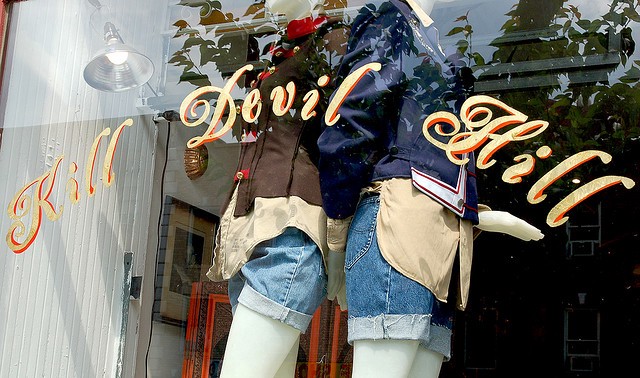Death of a Denim Wizard
by PJ Vogt

A couple of years ago, I went to get my jeans mended at a store in my neighborhood called Kill Devil Hill. It mostly sold New-Old Brooklyn tchotchkes — nice soaps, pharmaceutical brown bottles, fancy combs — but in the back of the shop was a tiny denim repair business. When I mentioned being embarrassed about the crater-sized holes in the crotch, the person behind the counter told me that, actually, crotches on jeans fail all the time; most jeans, if they fail, fail in the crotch. Since the repairs are cheap — twenty dollars or so — there’s a small army of people walking around with mended, reinforced, double-strength, nearly indestructible crotches.
So last week, when a friend told me that he was planning to buy some replacement jeans with a strong, healthy crotch, I informed him that he should just get his old jeans mended; he not only didn’t know about denim menders, but had no idea that crotch holes were the most widespread epidemic of our time. His confusion was so profound that I wondered if the person at the store had told me a polite lie — was the crotch hole epidemic really just me? So I went back to investigate.
There was a prominent sign in the store window:
PUBLIC ANNOUNCEMENT
WE ARE NO LONGER OFFERING SERVICES IN DENIM REPAIR
The woman who used to work there was gone. In her place was a soft-spoken teenager named Wyatt. He lives a few blocks away from the store. After a summer class at FIT, he discovered that he liked sewing, and walked into Kill Devil Hill to ask if he could intern for them. Now fifteen, he works a couple of days a week. He told me that the reason the store had phased out denim repair was because it wasn’t very lucrative; they made more money selling aprons.
When did the store start to phase out denim repair?
It took us two months to get rid of it. People were coming in and we were like, “Fine. One more pair, one more pair.”
What kind of jeans would people bring in to get repaired?
They’d tend to be high quality jeans. The pricing range was two hundred dollars and up. That’s the culture of denim repair: You don’t spend repair money on sixty-dollar jeans. I guess you might on jeans you’ve spent a lot of time with. The crotch blew out, the knees blew out — do you know a lot about raw denim?
Only a little bit.
So the whole thing is: you don’t wash your jeans. Most of my pairs I haven’t washed in nine months. When you wash jeans, it’s not that good for the denim. You don’t wash your jeans, they get fades, they get dirty. There are marks called the whiskers, that’s here —
— along the pocket?
Yeah. The marks behind the knees are called honeycombs. And most people, when you buy selvedge denim, you cuff it. If there’re cuffs, and you unroll the cuffs, you see faded lines. They’re called stacks.
It feels like — I know this is something adults are into — but it feels teenaged. Just because it’s a hobby with a lot of slang and language. You know?
Yeah. It’s weird, but I don’t see it much at school. Even though it does sound like that. Me and my best friend at school are the only ones with knowledge of selvedge jeans. All the other kids were wearing Levi’s and stuff like that. We were wearing APC and like, one of my favorite companies is Acne Studios. Which is like a designer brand.
When you would wear the better jeans, would kids notice?
I feel like even if they didn’t notice, I noticed. I knew. I can feel a difference between higher quality denim and lower quality or average quality. But I don’t think many people notice. I always think people are more observant than they are. It’s just another pair of jeans to somebody.
What kind of repairs do people tend to get? Is there a specific repair people get all the time?
The crotch repair. The crotch will rub up against your seat when you’re biking. That’s a pretty popular one. Also, the knee. I’d say knee and crotch — er, seat. “Seat” is less vulgar or whatever.
I got a pair of jeans repaired here maybe a year ago, and I was embarrassed because I felt like I had huge thighs that had destroyed my jeans.
It’s just where it fails. It’s pretty popular that the crotch will wear out. Er, the seat.
What about when people’s pockets show through because of their cellphone or their wallet? Is that even fixable?
Yeah. You can take the pocket off and replace it. You can remove the pocket and then fix the pocket and sew it back on. We can pretty much fix anything.

Do you think that there’s certain neighborhoods where you’re more likely to see a denim repair business?
Yeah. Greenpoint and Williamsburg, because of the hipster and fashion culture that’s emerged from these neighborhoods — the high quality jeans and the biking, where you destroy your seat.
I have a friend who just finished med school and she said she sometimes looks at strangers on the street and catches herself diagnosing them. Do you do that with people’s jeans?
I guess, probably. Since I started working here I notice — every time I’m walking down the street I notice — that guy’s wearing APC, that guy’s wearing Ralph Lauren. That guy bikes a lot, his seat is repaired.
It’s funny too. I feel like denim culture is people learning how to look at jeans, become like connoisseurs of jeans. But they might not have an appreciation for why good jeans work or why they’re better made.
The mender I remembered from a couple of years ago came into the store with her son, who is now a toddler.
This is my boss, Mary.
Hi! I’m doing a piece about denim repair, a business which you guys are out of now.
M: Oh, yeah, we’re out of the business of denim repair. It sucks ’cause I really liked the denim repair business.
How come?
I liked fixing something. Making the life of it longer. It was a service I believed in — it just became logistically difficult. I realized to keep doing it I’d have to up my prices. I was already the cheapest, and I figured, well, I either make people mad by upping my prices or I make them mad by not doing it.
I was checking your hours before I came and someone on Yelp was crazy mad that you’d stopped repairing denim, as if you were a hospital that had shut down.
I know. People have been really upset. You can’t make everybody happy all the time. And I only have this space to work in. If I had a way huger space, I’d consider doing it. But also, to be honest with you, I started getting horrible denim repair people.
What are horrible denim repair people like?
For the first few years I did it, everyone was so happy to have their jeans done. But since last November up to when I quit, I started getting these really, absurdly high-demanding people. Over like, a ten-dollar fix. They’d scream at me, yell at me, refuse to pay, to the point where I thought, I don’t need to get yelled at. Go pay more money somewhere else and yell at them. I had a woman who yelled at me for not doing her jeans on Christmas.
Seriously?
She came the day after Christmas, and I said, “I’m really sorry, we’re behind, it’s Christmas right now and we’re a retail store.” She said, “This is unacceptable, I shouldn’t have to pay anything. I had to take a thirty-dollar car ride.” And I was like, “I didn’t tell you to pay $30 to get over here.” Why wouldn’t you even call — it’s the day after Christmas, why would you even think I would be here? She was so horrible. I almost quit doing it at that point; I just thought, “People are crazy.”
That’s so insane. It makes me so embarrassed for my team, the customer team.
It got crazy. It was weird. We talked about it as a staff. To Victoria, who’s been with me the longest, I was like, “Have you noticed this too? Have I gotten more sensitive?” And she said, “No, it’s the customers.” It had gone from one mad person once every four months — someone you could still make happy — to, in the past months, just — really horrible people.
PJ Vogt hosts On the Media’s TLDR, a podcast about the internet.
Photos by RD the Milkman and Curious Expeditions, respectively
